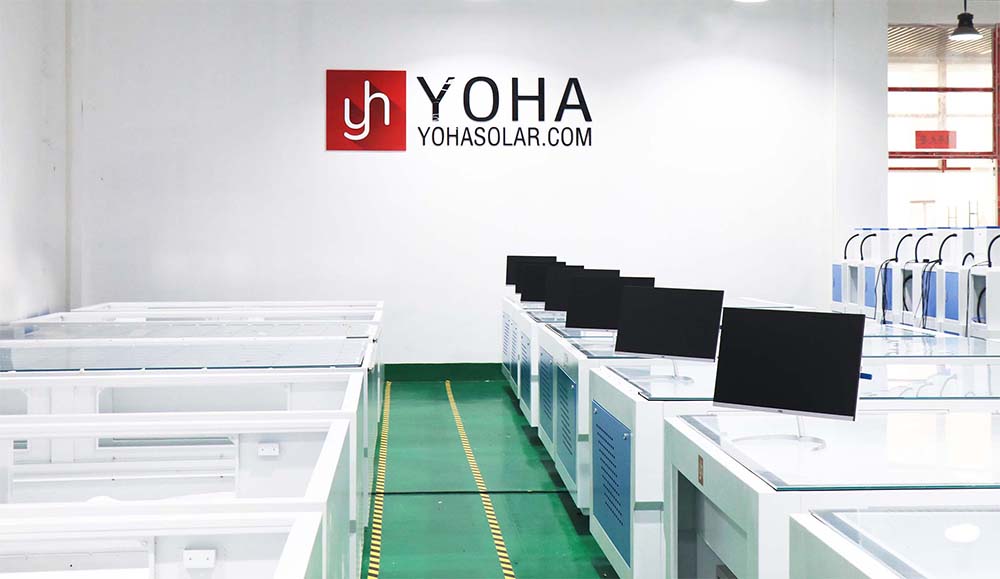Welcome to Wuhan Yoha Solar Technology Co., Ltd!
common problem
Site Map
Language:
 Chinese
Chinese
 English
English
Welcome to Wuhan Yoha Solar Technology Co., Ltd!
common problem
Site Map
Language:
 Chinese
Chinese
 English
English
In the solar photovoltaic manufacturing sector, while automated production lines offer high efficiency, they also come with relatively high investment costs. For small and medium-sized photovoltaic enterprises or startups, a 50MW solar module manual production line is an economical and practical choice. It meets production capacity requirements while effectively controlling initial investment costs. This article provides a detailed introduction to the manual production line's process flow, equipment configuration, advantages, and applicable scenarios, offering valuable insights for companies interested in investing in photovoltaic module production.
The 50MW solar module manual production line is a semi-automated production solution primarily operated manually, supplemented by essential key equipment. With an annual capacity of approximately 50 megawatts, it can produce around 1.1 million standard photovoltaic modules. This solution is particularly suitable for companies with limited capital but a desire to quickly enter the photovoltaic manufacturing industry, or as a transitional solution for temporary capacity supplementation.
Compared to fully automated production lines, manual production lines offer significant advantages in terms of equipment investment, factory requirements, and personnel training, while still ensuring basic module performance and quality. This solution is especially well-suited for regions with lower labor costs or niche markets with high demand for customized modules.

The core process flow of the manual production line is largely consistent with that of automated production lines, but certain steps replace mechanical operations with manual labor to reduce equipment costs. The main production steps include:
Cell Sorting and Testing
Manual sorting with simple equipment to inspect cell appearance and conduct EL testing, eliminating defective products.
Use of manual or semi-automatic testers for electrical performance grading to ensure cell parameter matching.
Cell Welding (Manual or Semi-Automatic)
Use of manual string welding stations or small semi-automatic string welding machines for cell interconnection. Operators require training to ensure welding quality.
Post-welding manual inspection for issues such as weak soldering or misalignment to ensure cell strings meet standards.
Layup and Material Placement
Manual placement of backsheets, EVA films, cell strings, and top-layer materials to ensure proper alignment and avoid bubbles or wrinkles.
This step demands high operator proficiency, as it directly affects the lamination quality of the modules.
Lamination (Key Automated Equipment)
The laminator is one of the few automated pieces of equipment in the manual production line, employing vacuum thermal pressing to ensure firm encapsulation and bubble-free modules.
Typically, 1-2 laminators are configured to meet the 50MW production capacity.
Framing and Junction Box Installation (Manual Operation)
Manual installation of aluminum frames, secured with corner brackets to ensure structural strength.
Manual welding of junction boxes and sealing with adhesive, followed by initial curing.
Testing and Packaging
Use of IV testers and EL detectors to evaluate the performance of finished modules, eliminating defective products.
Manual cleaning, labeling, and packaging before final storage.
Low Investment Cost and Short Payback Period
Equipment investment for a manual production line is about 30%-50% that of a fully automated line, significantly reducing initial financial pressure.
Lower factory requirements eliminate the need for high-specification cleanrooms, making it suitable for leased or repurposed existing facilities.
For a 50MW production scale, the payback period can be controlled within 2-3 years, making it ideal for small and medium-sized enterprises.
High Flexibility for Customized Production
Manual operations are more adaptable to producing modules of different specifications, such as double-glass or lightweight modules.
Suitable for small-batch, multi-variety orders to meet specific customer needs.
Higher Labor Demand, Suitable for Regions with Abundant Workforce
Manual production lines require more operators, making them well-suited for regions with lower labor costs.
Standardized training and quality management can still ensure a product pass rate of over 98%.
Serves as a Transitional Solution for Future Automation Upgrades
Companies can start with manual production lines to gain experience and gradually upgrade key equipment to semi-automated or fully automated systems as the market stabilizes.
Despite its many advantages, the 50MW solar module manual production line also faces certain challenges, including:
Lower Production Efficiency
Manual operations are slower, and capacity improvements rely on skilled workers.
Solution: Optimize production workflows and introduce semi-automated equipment (e.g., string welding machines) to enhance efficiency in critical steps.
Greater Difficulty in Quality Control
Manual operations are prone to deviations, such as poor welding or layup misalignment.
Solution: Strengthen employee training and implement multiple quality checkpoints to prevent defective products from advancing to the next stage.
Potential Long-Term Cost Increases
As labor costs rise, the cost advantages of manual production lines may diminish.
Solution: Introduce automated equipment at appropriate stages to gradually improve production efficiency.
The 50MW solar module manual production line is an ideal entry point for small and medium-sized photovoltaic enterprises, offering low investment, high flexibility, and strong adaptability. Although its production efficiency falls short of fully automated lines, with proper production management and quality control, it can consistently deliver qualified modules to meet regional market demands.
For companies with limited capital but a need for rapid production, the manual production line provides a viable solution and can be gradually upgraded based on market demands. As the photovoltaic industry continues to evolve, the integration of manual and automated production models will become a strategic choice for some enterprises.
keywords:TOP
18086473422
MESSAGE
